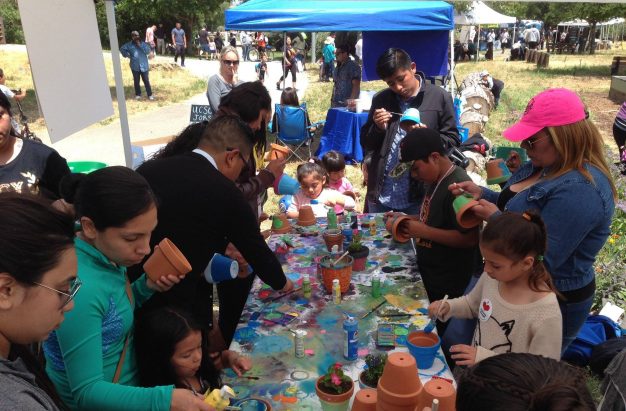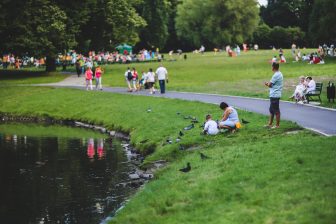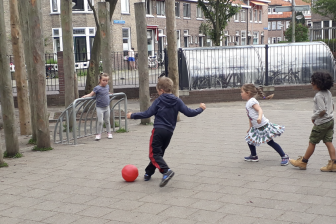
iVamos Afuera! – taking it outside in California
In this second part of their article about revisioning outdoor space as places of belonging, Jordin Simons and Victoria Derr explore one approach to building community connections to parks through a statewide initiative to engage children with the outdoor world.
A warm spring Saturday marked the second annual Take It Outside! iVamos Afuera! Salinas event, part of a statewide initiative that aims to “connect all Californians to great outdoor places and experiences” (TIO 2017) with local land trusts, parks agencies, or non-profits hosting a day-long event in a city park or natural area.
A partnership between the Big Sur Land Trust and many community-serving organizations, the event was designed to increase children and families’ comfort and security in coming to the park, as well as to promote fun and interest in the outdoors. The event was held in the community-created sanctuary of Natividad Creek Park, comprising 64 acres of restored park space. Salinas has made TIO a celebration of culture, people and nature by integrating a variety of activities including birdwatching, group exercises and yoga, a “skate jam” skateboarding competition, art activities, youth Latin Jazz performances, and Aztecan dance.
Nature is for everyone
The Local Urban Gardeners of Salinas provided art supplies for people to paint terracotta pots and soil to plant small flowers. Families and children gathered around the tables painting and planting at what became one of the most popular activities of the day. After the event a woman named Silvia approached the booth with her 8 year old daughter, asking, “Can we help plant the extra flowers?” She explained that this was one of her daughter’s favourite places. “I want her to grow up knowing nature. She always wants to come see these flowers.”
As we planted, Silvia’s daughter gravitated towards the pollinator plot, teeming with bees and lilac bushes. Planting, caring, and following the whims of nature provide a context for connecting with nature in a city that has little access otherwise. These are the places that Robert Michael Pyle has called sites of initiation, where “the borders between ourselves and other creatures break down” (1993, xvii). The park and the community event itself provide a context where Silvia’s daughter can learn that the park is a shared space where people gather and care for the place as well as each other.
The community played an integral role in shaping the context of these experiences, strengthening not only the possibility for connection to nature, but also connecting public spaces with social justice, by fostering spaces where nature is for everyone. In Black Faces, White Spaces, Carolyn Finney (2014) describes how society represents and reproduces the environment as something that only white, middle-class individuals care about. The importance of events such as Take it Outside thus help shift this thinking to a more inclusive space, one in which experiences can be owned and shared by people of multiple colours and contexts.
Inclusive outdoor spaces
By bringing the community together in an inclusive public space, children and families may feel more welcome in natural spaces and their community as a whole. Community psychologists emphasize that attachment to particular community places provides an important motivation for people to spend more time outdoors (Mihaylov and Perkins 2014). In her evaluation of creating cultural bridges for Latino/as and parks, Irma Cuevas (2016) suggests that it is this very re-visioning of what time spent outside means that is essential to fostering greater inclusivity in parks. Events like ¡Vamos Afuera! may help foster on-going relationships and a sense of place that help the community feel it belongs.
Jordin Simons and Victoria Derr
Photo: Take it Outside Salinas
Jordin Simons is a student at California State University Monterey Bay and spent much of her spring semester working in the community garden at Natividad Creek Park. Victoria Derr is an Assistant Professor in Sustainability Education at CSUMB
The first part of this article Parks as sites of belonging, can be read here
References
Cuevas, Irma. 2016. Heritage in the Outdoors: Creating a Cultural Bridge Between the Latino Community and Parks: A Case Study of Sonoma County, California. MA thesis, Sonoma State University, Sonoma, California.
Finney, Carolyn. 2014. Black Faces, White Spaces: Reimagining the Relationship of African Americans to the Great Outdoors. The University of North Carolina Press.
Mihaylov, Nikolay and Douglas D. Perkins. 2014. Community Place Attachment and its Role in Social Capital Development. Pp. 61-74 in L. C. Manzo and P. Devine-Wright (Eds.), Place Attachment: Advances in Theory, Methods and Applications. Abingdon: Routledge.
Pyle, Robert Michael. 1993. The Thunder Tree: Lessons from an Urban Wildland. New York, New York: The Lion’s Press.
TIO (Take it Outside). 2017. Take it Outside California. http://takeitoutsideca.com/




